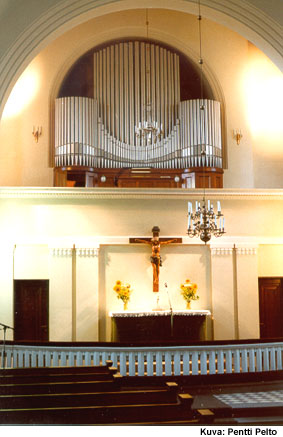|
HISTORICAL ORGANS IN FINLAND 
Karkku Church- Kangasalan Urkutehdas 1913
- 12 stops, 2 manuals and pedal
- pneumatic action and pneumatic stop action
The greystone church of Karkku was designed by Oiva Kallio and completed in 1913. It is a triple-nave church with a semi-circular apse. The ground floor of the apse houses the sacristy; the first floor houses the organ. The organ was completed in the same year as the church. It has remained unchanged in its sound and technical features except for the addition of a blower. The sharp change of the disposition and sound from the days of Bror Axel Thulé is due to a new director, Martti Tulenheimo.
The free-standing façade pipes in the Karkku organ were a novelty in their day. This design principle was only just emerging at the time. A generation shift had occurred at the Kangasala organ builders, and the architect of the church must have had a hand in designing the organ façade too.
Façade and structure
The free-standing zinc pipes in the façade are in two staggered rows. The small middle flat consists of dummy pipes, but the pipes of the flanking towers, together with some of the other larger pipes, are speaking. Some of the façade pipes have highlighted lips, and there is a decorative brass ring near the top of the pipes in the middle flat. The design is balanced and calm.
The chests, with the pipes arranged alternately, are in line. Behind the façade is the Manual I chest, then the Manual II swell box, then the Pedal chest. The large double rise reservoir is under the organ, and under that lie two feeder bellows whose foot levers are still in working order.
The Manual chests are typical for their period, but the Pedal chest displays certain features that did not become common until later. This instrument seems to have been a test case of sorts. The console is in front of the organ, and the organist sits facing the church. The manual keyboards have celluloid and ebony coverings. The pedalboard has been replaced.
Musical properties
The number of compound stops was decreased around the turn of the 20th century, but new compound stop types were soon added. Manual I of the Karkku organ has a Rauschquint 2x. The high wind pressure (103 mm) enabled a loud voicing and a characteristic sound. In the excellent acoustics of the church, the organ sounds like a great organ despite its small size. The sound colours are sharp but not aggressive. The great flute stops have a rich sound that augments the whole. The sound is not unlike that of a harmonium, which had become widespread in Finland at the time of the building of this organ.
Disposition
Manual I C-f3 | Manual II C-f3 | Pedal C-d1 |
Borduna 16’ | Geig.principal 8’ | Subbass 16’ |
Principal 8’ | Dubbelflöjt 8’ | I-Ped |
Konsertflöjt 8’ | Aeoline 8’ | II-Ped |
Gamba 8’ | Voix celeste 8’ | |
Oktave 4’ | Salicet 4’ | |
Rauschq. 2 2/3’ 2’ | II 16’ | |
II-I | | |
I 4’ | | |
II-I 16’ | | |
| | |
| | |
| | |
| | |
|